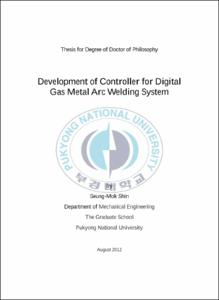Development of Controller for Digital Gas Metal Arc Welding System
- Abstract
- Welding is widely used in several industrial fields such as shipbuilding industries, automobile industries, railway equipment, aircraft, spacecraft and components manufacturing business. Specially, Gas Metal Arc Welding (GMAW) is the most popular welding machine which is used in various industries. It can be used to weld most of commercial metals and alloys. The GMAW process can be done in all positions with higher welding speed, and deeper penetration of the weld rather than other welding method. Furthermore, GMAW process makes automation in welding process becomes easier by combining this process with mobile robot. The development of electronic and electrical technology drags the development of GMAW. The previous control system of GMAW has problems such as no guarantee of stability due to the fixed parameters in PID controller, no guarantee of stability due to the difference between predicted trajectory and actual trajectory in MPC and chattering phenomenon in SMC. To solve the problems of conventional controllers and increase the quality of welding process, it is necessary to present modeling and to develop new and improved control algorithms for automatic digital Gas Metal Arc Welding (GMAW) process. Therefore, the following tasks are implemented in this dissertation. Firstly, the hardware configuration of GMAW system is proposed. The system consists of shielding gas, Gas Metal Arc Welding Power Supply (PS-GMAW), Wire Feeding Unit (WFU) and travel beam. The PS-GMAW consists of rectifier, inverter, transformer, sensors, control board, DC motor driver and IGBT driver. A control system is based on DSP TMS320F28335 technology. Then, based on the proposed GMAW system, the mathematical modeling of GMAW system is presented. Based on this mathematical modeling, the control algorithm is proposed. To verify the proposed controller, this mathematical modeling also is used in simulation. Secondly, self-tuning Fuzzy Proportional?Integral?Derivative (PID) controller is designed and applied to control the welding current to be constant by controlling the wire-feed speed of the Wire Feeding Unit (WFU). The automatic parameter self-tuning by fuzzy algorithm in the Fuzzy PID controller can solve the problem with limitation of stability due to fixed parameters in PID controllers. Thirdly, Fuzzy Sliding Mode Control (FSMC) is proposed to enhance the quality of the welding result. By fuzzifying the sliding surface, the feedback control gain from the fuzzy inference rule base is obtained. Moreover, based on dynamics modeling of Wire Feeding Unit (WFU), Fuzzy Sliding Mode Control (FSMC) is proposed to change the electrode feed rate in order to achieve the output welding current to the setting value. The FSMC can solve the chattering phenomenon of SMC. Based on modeling of GMAW Power Supply (PS-GMAW), P controller is proposed to keep the output welding voltage of GMAW Power Supply to the setting value. Finally, the Kalman filter algorithm is proposed. This algorithm is suitable to estimate the value with noisy information. This dissertation presents a method to dynamically observe two important variables of a GMAW process, i.e. arc voltage and welding current. The proposed controller can easily control the welding output using the values estimated by Kalman filter algorithm.
Simulation and experimental results show that the welding current and voltage of the digital GMAW system are successfully controlled by the proposed controllers. Therefore, the simulation and experimental results shows the effectiveness and applicability of the proposed controllers for the digital GMAW system.
- Issued Date
- 2012
- Awarded Date
- 2012. 8
- Type
- Dissertation
- Publisher
- 부경대학교
- Affiliation
- 부경대학교 대학원
- Department
- 대학원 기계공학부지능기계공학전공
- Advisor
- 김상봉
- Table Of Contents
- Chapter 1 : Introduction. 1
1.1.Background and motivation 1
1.2. Review of previous studies 4
1.3. Problem statements 5
1.4. Objective and researching method 7
1.5. Content and summary of contributions 7
Chapter 2 : Theoretical background and system design 10
2.1. Basic concepts of welding machines 10
2.2. Mathematical modeling 15
2.2.1. Dynamics 17
2.2.2. Force affecting droplet dynamics 19
2.2.3. Reset conditions 21
2.2.4. DC motor of Wire Feeding Unit (WFU) 25
2.3. Hardware configuration of the proposed system. 27
2.3.1. Shielding gas 28
2.3.2. Gas Metal Arc Welding Power Supply 30
2.3.3. Wire Feeding Unit (WFU) 41
2.3.4. Travel beam 41
Chapter 3 : Control design using self-tuning Fuzzy PID. 43
3.1. Introduction 43
3.2. Model of WFU 44
3.3. Controller design 47
3.3.1. Normalization 50
3.3.2. Fuzzification 50
3.3.3. Fuzzy rule and fuzzy inference 52
3.3.4. Defuzzification 54
3.4. Simulation and experimental results 55
3.4.1. Identification of parameters for transfer function 55
3.4.2. Simulation and experimental results 57
3.5. Summary 67
Chapter 4 : Control design using Fuzzy Sliding Mode Control 68
4.1. Introduction 68
4.2. Controller design 69
4.2.1. Design of Voltage Controller for Gas metal Arc Welding Power Supply 69
4.2.2. Design of Current Controller for Wire Feeding Unit 70
4.3. Simulation and experimental results 76
4.3.1. Identification of parameters for the transfer function 76
4.3.2. Simulation results 77
4.3.3. Experimental results 82
4.4. Summary 90
Chapter 5 :Kalman filter. 91
5.1. Introduction 91
5.2. Kalman filter design 92
5.3. Simulation results 98
5.3.1. Kalman filter applied in self-tuning Fuzzy PID controller. 101
5.3.2. Kalman filter applied on Fuzzy Sliding Mode Control 108
5.4. Summary 114
Chapter 6 : Conclusions and future works. 115
6.1. Conclusions 115
6.2. Future works 118
References 119
Publications and conferences 128
Appendix 131
- Degree
- Doctor
- Appears in Collections:
- 대학원 > 기계공학부-지능기계공학전공
- Files in This Item:
-
-
Download
 Development of Controller for Digital Gas Metal Arc Welding System.pdf
기타 데이터 / 2.87 MB / Adobe PDF
Development of Controller for Digital Gas Metal Arc Welding System.pdf
기타 데이터 / 2.87 MB / Adobe PDF
-
Items in Repository are protected by copyright, with all rights reserved, unless otherwise indicated.